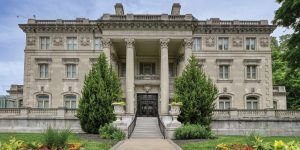
By Angie Baldelomar
When Isaac Tapia and Rodrigo “Rico” Alvarez started doing murals, they could never have imagined they would become a sought-after muralist duo in the Kansas City area.
Tapia and Alvarez — from Mexico and Uruguay, respectively — met when they attended Paseo Academy. Years later, they reconnected and worked on their first mural together, thanks to Alvarez’s sister. She asked Alvarez to paint a blank wall at the school she worked at after the muralist they had bailed. Alvarez, who did more work in metal sculpting than anything else, agreed to do it.
“When it came down to making this mural, I gave it a try for maybe an hour, and I started painting with small, tiny brushes — and then, I was like, ‘There’s no way I’m doing that,’” Alvarez said.
Then, he called Tapia to come help, starting their journey as muralists together.
The school liked their mural, they recalled, and they were called back for a second mural.
“After that second mural, we realized we could do this for a living,” Tapia said.
Tapia and Alvarez went “door-to-door” to businesses around Kansas City, Missouri’s Northeast area and advertised their work as muralists. They did that for a year. The second year, Tapia recalled, they started receiving calls to paint murals. From there, their business grew.
Iola, Kansas, was another turning point in their careers as muralists, they agreed. They were selected to paint a mural in Iola, opening other traveling opportunities. Since then, they’ve done murals in Las Vegas, Nevada; Iowa; Los Angeles; and Massachusetts.
Doing murals is great for getting to know communities, Tapia said, because murals are all about the community.
“Whenever we try to paint a mural, we don’t really want to put a pretty picture up; it’s more of … (us saying), ‘Let’s do a little bit of research on the community so that we can put something cool up — (something) that represents the community,’” he said.
“It tends to become a weaved-in icon in that community and it’s recognizable to where everyone knows,” Alvarez added. “It becomes part of that community, organically, and beautifies it.”
One of their biggest accomplishments was being asked to paint a mural at the new Kansas City Airport.
“Not even applying for anything art-related in the new airport, we still got called in to paint murals in the new airport,” Tapia recalled.
It was all because of the connections they had created with other area small businesses where they painted murals.
“Small businesses were what gave us the opportunity to be painting at the airport,” Tapia said. “They recommended us to paint over there and that was the reason they called us.”
Working together has become second nature, the duo agreed.
“I think the best way that I can put it is that, whenever it comes to our mural work, we complement each other because what is our strength in our own personal work is basically what the other person lacks,” Alvarez said.
Tapia and Alvarez have been featured in the KCPBS documentary “We Are Latinos II.” They also have their solo work on display at The Nelson-Atkins Museum of Art in Kansas City, Missouri, as part of the exhibition “A Layered Presence.”
For more information on their work, visit itraicons.com.
Muralistas locales llenan de arte las calles de KC

Cuando Isaac Tapia y Rodrigo “Rico” Álvarez comenzaron a pintar murales, nunca se imaginaron que se convertirían en un dúo muralista muy solicitado en el área de Kansas City.
Tapia y Alvarez, de Mexico y Uruguay respectivamente, se conocieron cuando asistían a Paseo Academy. Años más tarde, se reconectaron y trabajaron juntos en su primer mural, gracias a la hermana de Álvarez. Le pidió a Álvarez que pintara una pared en blanco en la escuela en la que trabajaba después de que el muralista al que habían dejado en libertad bajo fianza. Álvarez, que se dedicaba más a la escultura en metal que a cualquier otra cosa, accedió a hacerlo.
“Cuando llegó el momento de hacer este mural, lo intenté durante tal vez una hora y comencé a pintar con pinceles pequeños, diminutos, y luego pensé: ‘No hay forma de que haga eso’”, Álvarez dijo.
Entonces, llamó a Tapia para que lo ayudara, comenzando así su camino como muralistas.
A la escuela le gustó su mural, recordaron, y los llamaron nuevamente para un segundo mural.
“Después de ese segundo mural, nos dimos cuenta de que podíamos ganarnos la vida con esto”, dijo Tapia.
Tapia y Alvarez fueron “puerta a puerta” a negocios alrededor de Kansas City, en el área noreste de Missouri, y anunciaron su trabajo como muralistas. Lo hicieron durante un año. El segundo año, recordó Tapia, empezaron a recibir llamadas para pintar murales. A partir de ahí, su negocio creció.
Iola, Kansas, fue otro punto de inflexión en sus carreras como muralistas, coincidieron. Fueron seleccionados para pintar un mural en Iola, lo que abrió otras oportunidades de viaje. Desde entonces, han realizado murales en Las Vegas, Nevada; Iowa; Los Angeles; y Massachusetts.
Hacer murales es excelente para conocer las comunidades, dijo Tapia, porque los murales tienen que ver con la comunidad.
“Cada vez que intentamos pintar un mural, en realidad no queremos poner un cuadro bonito; es más de… (que nosotros digamos), ‘Investiguemos un poco sobre la comunidad para que podamos presentar algo interesante, (algo) que represente a la comunidad’”, dijo.
“Tiende a convertirse en un ícono entretejido en esa comunidad y es reconocible por todos”, agregó Álvarez. “Se convierte en parte de esa comunidad, de forma orgánica, y la embellece”.
Uno de sus mayores logros fue que le pidieran pintar un mural en el nuevo aeropuerto de Kansas City.
“Ni siquiera solicitamos nada relacionado con el arte en el nuevo aeropuerto, y aun así nos llamaron para pintar murales en el nuevo aeropuerto”, recordó Tapia.
Todo se debió a las conexiones que habían creado con otros pequeños negocios de la zona donde pintaban murales.
“Los pequeños negocios fueron los que nos dieron la oportunidad de estar pintando en el aeropuerto”, dijo Tapia. “Nos recomendaron para pintar allí y por eso nos llamaron”.
Trabajar juntos se ha convertido en algo natural, coincidió el dúo.
“Creo que la mejor manera que puedo decirlo es que, cuando se trata de nuestro trabajo mural, nos complementamos porque nuestra fortaleza en nuestro trabajo personal es básicamente lo que le falta a la otra persona”, dijo Álvarez.
Tapia y Álvarez han aparecido en el documental de KCPBS “We Are Latinos II”. También exhiben su trabajo individual en el Museo de Arte Nelson-Atkins en Kansas City, Missouri, como parte de la exposición “A Layered Presence”.
Para obtener más información sobre su trabajo, visite itraicons.com.










